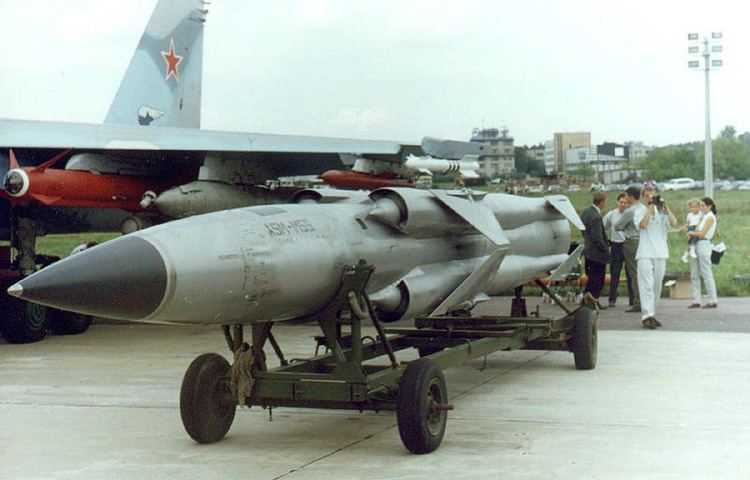Type Anti-ship missile | Produced 1983 | |
 | ||
In service 1984, the first ship with 3M80 missiles was actually ready in 1978, formally adopted in 1981 Used by Soviet Union, Russia, China, Egypt | ||
The P-270 Moskit (Russian: П-270 «Москит»; English: Mosquito) is a Russian supersonic ramjet powered Anti-Ship missile. Its GRAU designation is 3M80, air launched variant is the Kh-41 and its NATO reporting name is SS-N-22 Sunburn. The missile system was designed by the Raduga Design Bureau during the 1970s as a follow up to the "SS-N-9 Siren". The Moskit was originally designed to be ship-launched, but variants have been adapted to be launched from land (modified trucks), underwater (submarines) and air (reportedly the Sukhoi Su-33, a naval variant of the Sukhoi Su-27), as well as on the Lun-class ekranoplan. The missile can carry conventional and nuclear warheads. The exact classification of the missile is unknown, with varying types reported. This uncertainty is due to the secrecy surrounding an active military weapon. The Moskit is one of the missiles known by the NATO codename SS-N-22 Sunburn.
Contents
The missile has been purchased and exported to the People's Liberation Army Navy (China) and Indian Navy (India).
Design
It reaches a speed of Mach 3 at high altitude and Mach 2.2 at low-altitude. This speed is 4.25 to 3 times more than speed of the subsonic American Harpoon. When slower missiles, like the Harpoon or the French Exocet are used, the maximum theoretical response time for the defending ship is 120 to 150 seconds. This long response time provides time to launch countermeasures and employ jamming before deploying "hard" defense systems such as missiles and close-in weapon systems. But the high speed of the 3M82 "Mosquito" missiles reduce the maximum theoretical response time for the defending ship to 25 to 30 seconds. This short response time makes jamming and countermeasures very difficult, and firing missiles and quick-firing artillery even more difficult. The Moskit was designed to be employed against smaller NATO naval groups in the Baltic Sea (Danish and German) and the Black Sea (Turkish) and non-NATO vessels in the Pacific (Japanese, South Korean, etc.), and to defend the Russian mainland against NATO amphibious assault. The missile can perform intensive anti-defense maneuvers with overloads in excess of 10g, which completed for 9 km before the target.
Variants of the missile have been designated 3M80M, 3M82 (Moskit M). The P-270 designation is believed to be the initial product codename for the class of missile, with the Russian Ministry of Defense GRAU indices (starting with 3M) designating the exact variant of the missile. The 3M80 was its original model. The 3M80M model (also termed 3M80E for export) was a 1984 longer range version of the missile, with the latest version with the longest range being the 3M82 Moskit M. The ASM-MSS / Kh-41 variant is the 1993 air-launched version of the missile.
The 3M80MVE variant has an optional longer 240 km range through a second, high-altitude flight profile setting, however using the higher altitude profile would make the missile detectable at much greater distances.
Specifications
3M80 – 90–120 km (56–75 mi; 49–65 nmi) (surface ship); 250 km (160 mi; 130 nmi) (aircraft)
3M80E – 120 km (75 mi; 65 nmi) (surface ship)
3M80MVE – 140 km (87 mi; 76 nmi) (surface ship, low-altitude trajectory); 240 km (150 mi; 130 nmi) (surface ship, combined trajectory)
